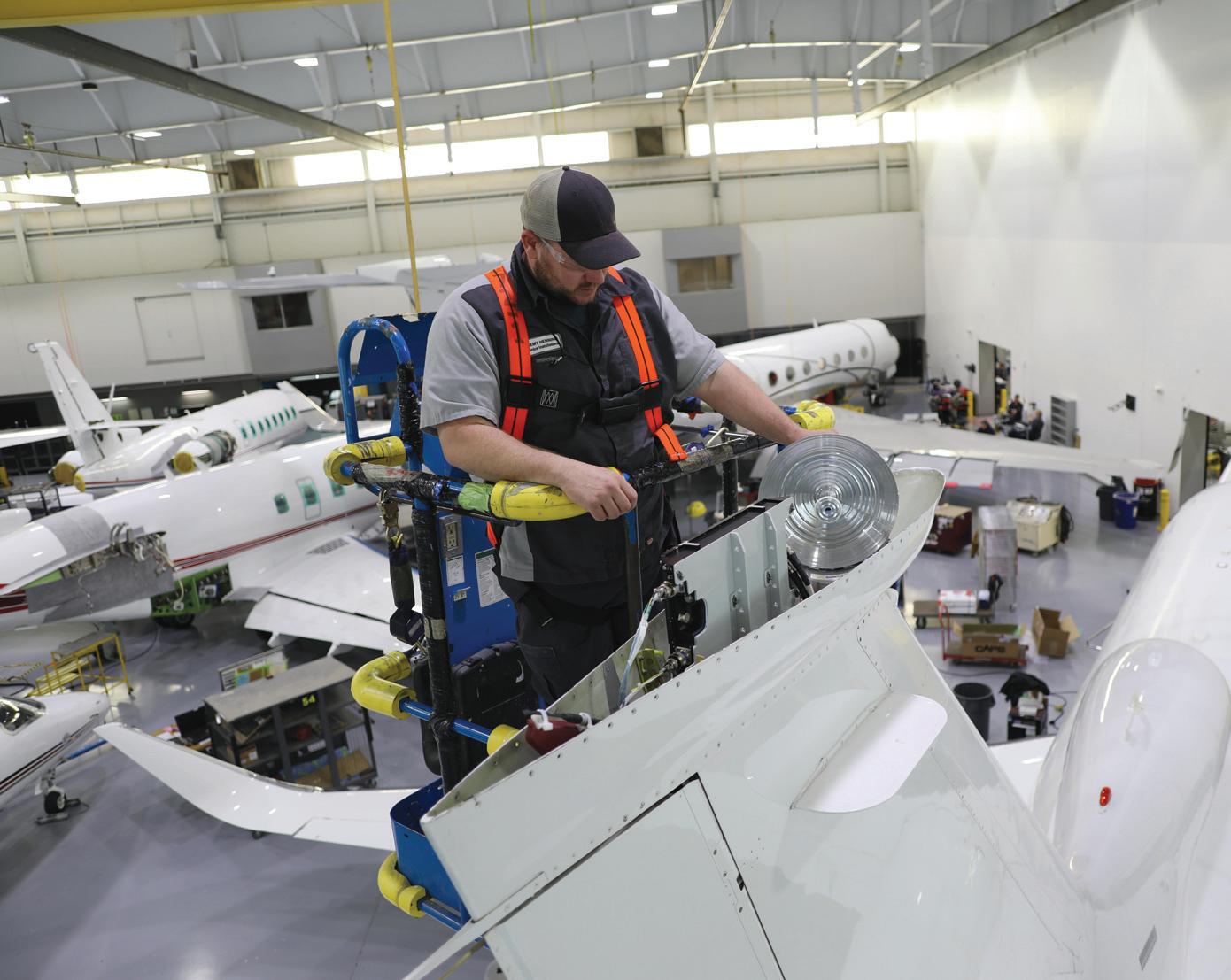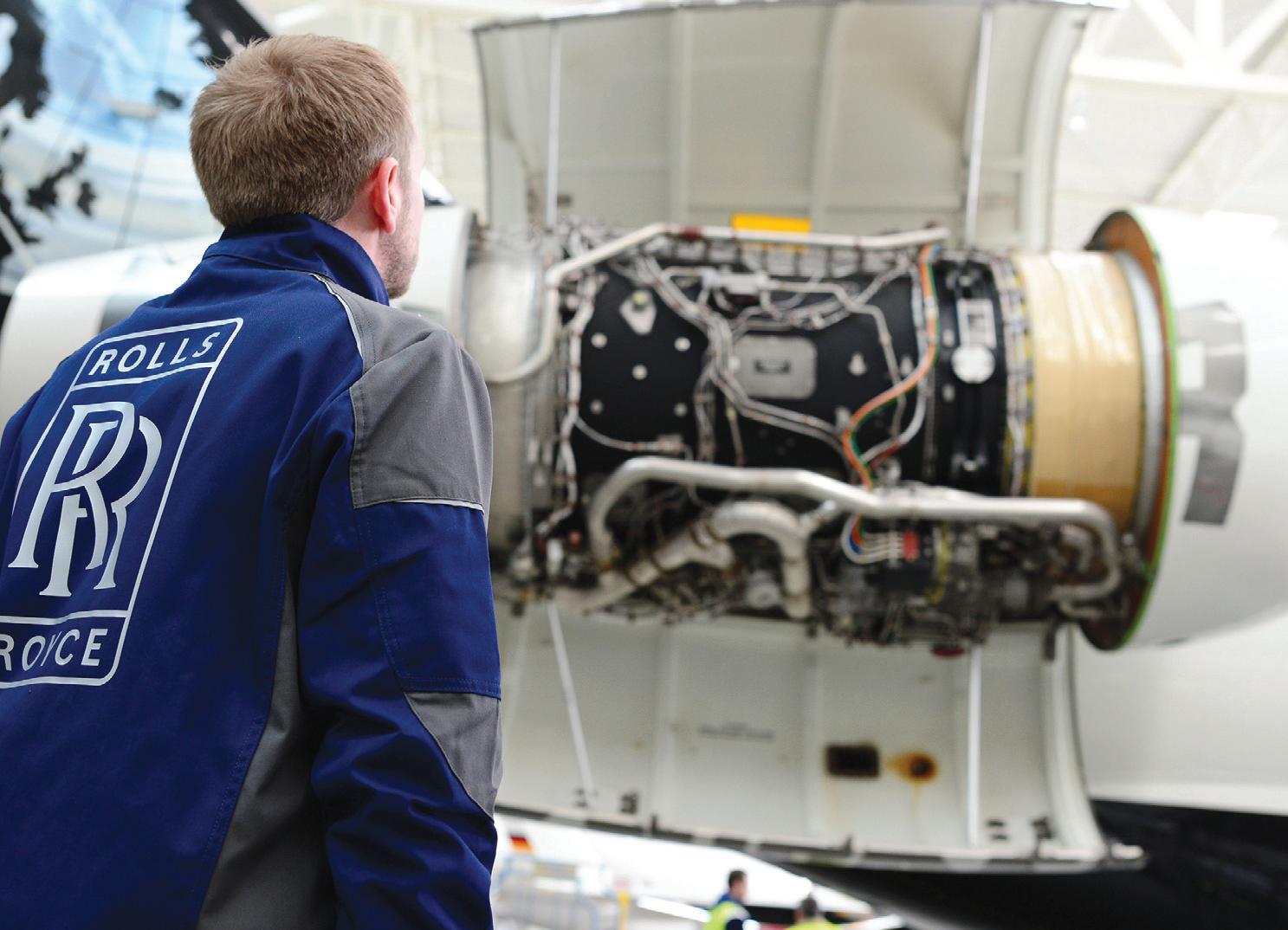
15 minute read
GE OnPoint
Hourly Maintenance Programs: Getting Value for Money
Do today’s aircraft maintenance programs offer owners and operators flexibility to get optimal value for money without significant exposure to expensive maintenance risks? Gerrard Cowan asks the experts and highlights some of the ‘gotchas’.
Advertisement
Hourly maintenance programs offer business jet and turboprop operators a high degree of security, with the knowledge that their engines, avionics, airframe, APUs, and/or parts will receive the maintenance they need.
But in a challenging economic climate, how can operators ensure they get the best value for money, while still guaranteeing the coverage they need?
According to Francisco Zozaya, Jet Support Services Inc’s (JSSI’s) Chief Revenue Officer, the Hourly Cost Maintenance Programs (HCMPs) offered by JSSI are “a bespoke service for our customers”, with different coverage options, depending on their requirements and level of risk tolerance.
It includes a “tip-to-tail” program for the entire aircraft, along with engine-only, or partsonly coverage.
With concerns on the horizon for operators, notably supply chain shortages which are unlikely to end any time soon, Zozaya believes “in the coming years there will be more demand for HCMPs, since having a maintenance program in place means better access to scarce parts and engines, and additional peace of mind.”
JSSI provides coverage for a range of aircraft equipment and components, from engines, to avionics, to APUs – and the nature of the coverage is strongly affected by the system in question.
“It will also depend on an operator’s use of the business jet - because scheduled maintenance is determined by either calendar date or usage,” Zozava adds. “An operator with a more intense schedule and higher hourly and cycle usage is going to need inspections sooner.
“They may see higher maintenance costs within a smaller time, compared to a low usage user – especially when their maintenance is hourly, and cycledriven.”
Moreover, operators of older

and higher usage aircraft can expect more unscheduled risk, since these aircraft are more susceptible to unscheduled maintenance requirements.
No One-Size-Fits-All
Honeywell provides maintenance programs for a range of systems, including engines, engine nacelles, APUs, and mechanical and avionics components. Nadya Krisko, Senior Director of Business and General Aviation, EMEIAI, highlights that the company’s Maintenance Service Plan (MSP) is designed to provide flexible options and cut back on unplanned maintenance costs and unnecessary downtime.
“Pay-as-you-go maintenance can result in unmanageable costs and insufficient maintenance budgets, especially when multiple unexpected failures happen,” she warns. “This can also lead to an extended aircraft downtime.”
With MSP, business jet operators can choose to cover particular systems and components, or opt for broader coverage across the aircraft. There are also different service levels, extended service coverage, and consigned inventory management options, while the MSP Gold Level Service provides a 24/7 Road Crew Service and Extended Troubleshooting.
“There is no ‘one size fits all’,” Krisko highlights. “Each operator has a unique operation, whether short flights, long-range flights, flying into remote destinations, operations in areas with a comprehensive MRO network, Minimum Equipment List items to consider, new versus pre-owned aircraft, flight hours flown annually, and other factors.
“These will all be parameters defining individual priorities,” she illustrates, adding that in general, engine and APU coverage appear to be a higher priority over avionics.
Similarly, the type of system involved will impact coverage in numerous ways. For example, turbine engines will be subject to such processes as Major Periodic
Inspections (MPIs), which “can be pricey, and their cost may vary depending on whether there are any issues identified that need to be fixed to keep the engine in working order,” Krisko explains.
On top of that, operators need to consider Life Limited Parts (LLP) replacement for APUs and engines once they have reached the end of their lives, which is something that’s less of a concern on mechanical and avionics components, Krisko says. Such concerns are factored into the company’s MSPs.
Balancing Budget with Maintenance Demand
Delray Dobbins, Senior Manager, Eagle Service Plan (ESP) Sales & Global Strategy at Pratt & Whitney Canada says the right hourly engine maintenance programs allow operators to balance budgetary needs with engine maintenance demands.
“The benefits of hourly maintenance plans apply to all engines, no matter the type,” he argues. “Even when an engine is highly reliable, with high mission availability, hourly maintenance plans help operators pay less over the life, or length of ownership, of their aircraft.
“This comes from cost savings associated with both scheduled and unscheduled maintenance,” he explains.
Pratt & Whitney Canada’s ESP was traditionally built on four levels of coverage – Silver, Silver Lite, Gold and Gold Lite – but has since been simplified to two: ESP Gold and Platinum.
“The data showed customers didn’t really want more than two coverage levels, and the trend is definitely for customers today to want more of a turn-key solution for their engine needs,” Dobbins observes. (While the Gold and Platinum options are offered to new customers, the company continues to honor those who signed up to the Silver or Silver Lite coverage previously.)
The company offers a range of other benefits, depending on an operator’s need. For example, operators of engines like the PW300 can combine the ESP hourly plan with digital engine health monitoring services, while, as well as ESP, P&WC offers a Fleet Management Program (FMP) for those operating six or more aircraft.

Shop Scheduling
Steve McManus, Sales Director for GE Aviation, highlights that his company’s OnPoint program provides exceptional levels of availability through dedicated slots for shop visits, along with full risk transfer for an engine’s service and maintenance needs.
“OnPoint addresses and eliminates lifecycle cost spikes while offering a great option for long-term operational readiness,” he adds, highlighting that it especially eliminates induction time and turn time for customers.
“There are occasional surprises even with on-condition engines, so we’ve also invested in our field and technical support staff to proactively manage customer’s needs,’ McManus added. “These practices help insulate customers from market swings or pricing increases because of built in supply practices and defined economic adjustments.”
Selecting Coverage Levels: Beware the “Gotchas”
According to Dobbins, there are two common ‘gotchas’ to look out for when it comes to choosing the right coverage level.
First, consider your geographic needs. If you operate in a saline environment, corrosion coverage is a vital part of your package. The second ‘gotcha’ relates to Life Limited Parts (LLPs)…
“When an engine goes through an overhaul, the LLPs are not reset to zero hours – their limit is fixed,” he highlights. “That means buyers of older, or higher-time aircraft (perhaps one formerly flown in a Fractional Ownership program) need to be especially careful about the level of coverage they choose.
Some coverage levels include LLPs, some don’t. “When parts reach their limit, if the owner hasn’t selected the right level of coverage, they will find that while the overhaul cost is covered, the cost of LLP replacement isn’t, which could result in a bill of as much as $1.5m per engine.”

PHOTO COURTESY OF GE AVIATION

Krisko suggests the big ‘gotchas’ can be avoided with the right questions being asked. “Ask whether the maintenance provider will stand by the quality of its services and has a good reputation in the industry,” she advises. “Consider the types of spare parts that will be installed, and whether the plan fully covers parts and maintenance.”
Operators should also establish whether LLPs will be replaced with new parts within the plan, she adds. “And operators should check whether upcoming and existing upgrades and service bulletins are included in the coverage, and whether the annual minimum of the plan matches the utilization.”
There are other questions operators should ask, too, including whether the service centers are easily accessible from their base and other regular flying destinations? Does the plan cover off-site support? Will the support be given by a maintenance provider that can make it easy for operators to choose from a range of selectable coverage options, tailored to their platform and operations?
Zozaya reiterates that customers must first understand their projected utilization and the type of operation they will have – for example, there’s a big difference between private travel and charter use.
Second, he advises, they should ask whether they’re looking for a one-stop service that requires a HCMP, or just need parts supplied, with maintenance handled in-house.
The big question, Zozava summarizes, is whether you, as the aircraft owner, are ultimately comfortable taking on the inevitable peaks and troughs of maintenance costs, or if you would be more comfortable with consistent, stabilized costs?
The answer will establish whether a maintenance program is right for you, and, if so, the extent of the program coverage you ultimately choose. ■
More information from: • GE: www.geaviation.com/services/regional-business/onpoint • Honeywell: https://aerospace.honeywell.com/us/en/learn/services/ maintenance-and-service-plans • JSSI: www.jetsupport.com • Pratt & Whitney Canada: www.pwc.ca/en/products-and-services/services/ maintenance-programs-and-solutions/maintenance-programs/
GERRARD COWAN is a freelance journalist who focuses on aerospace and finance. In addition to his regular features in AvBuyer, Gerrard's work has appeared in the Wall Street Journal and Janes, among others. Gerrard can be found on Twitter: @GerrardCowan
ATLAS AIR SERVICE AG:
Full Service and Support for Modern Avionics in your Business Jet!

Why Atlas Air Service AG?
As an established provider of state-of-the-art avionics solutions for business aircraft, Atlas Air Service AG, together with its subsidiaries Augsburg Air Service and Altenhrein Aviation, offers customized solutions for Embraer Executive Jets, the Cessna Citation jet family, Beechcraft King Air Series, and Gulfstream G100 and G200 Series.
Atlas Air Service was founded over 50 years ago and has grades to the complete satisfaction of its customers. The company has been a constant in the ever-changing avionics industry and has continually invested in employee training and state-of-the-art tools and procedures.
“A key component of our service is our constant drive to improve and evolve,” said Radu Grigore, Deputy Manager – MRO Commercial. “We are continually working to improve ourselves and our customers’ experience of our maintenance operations. We can offer customers a wide range solutions to almost any customer request. To achieve this, we are in close contact with the best avionics suppliers in the market.” Atlas Air Service Avionic Installations include:
› Garmin G5000 for Citation XLS › Garmin G1000 NXi for Phenom 100/300 › Collins Pro Line Fusion for Cessna 525 Series › Garmin G600 TXi and GI 275 installations › Garmin GTN 650/750Xi upgrades › Cabin LED lights installation › iPad/tablet holders for cabin and cockpit › DU-875 Installations for Legacy 600/650 › FANS over Iridium installations for Legacy 600/650 › ADS-B Out upgrades › Honeywell FMS upgrade 6.1 for Legacy 600/650 › KA-Band Hi-Speed internet installation › Head-Up Display installation › Enhanced Vision System installation
+49 421 53658 -760 mro-sales@aas.ag www.aas.ag
Rolls-Royce: Striving for Engine Support Perfection
Can the challenge of meeting and exceeding engine maintenance support expectations ever be truly complete? AvBuyer spoke with Rolls-Royce about the engine OEM’s efforts to enhance customer support and pursue perfection…
Since the very early days of Business Aviation, RollsRoyce has been providing powerplants to the leading business jet OEMs, with Rolls-Royce engines today providing the power for some of the quickest, and longest-range private jets available on the new and pre-owned markets.
Nowadays, there are more than 3,300 Rolls-Royce-powered bizjets in operation around the world. Given the propensity for OEMs building large cabin and long-range aircraft to select Rolls-Royce engines as their powerplants – the types of jets appealing to operators in many of the world’s developing Business Aviation markets – the maintenance and support requirements of owners and operators is spread far and wide around the planet.
That’s a testament to the success of the engines, but also a challenge to Rolls-Royce, which needs to ensure owners and operators enjoy seamless support, irrespective of whether they’re based in a region where the nearest qualified maintenance support is only a couple of hours away, or they’re in a remote area of the world where support and parts are scarce, and an Aircraft On Ground (AOG) event has the potential to be highly problematic.
How does Rolls-Royce manage to keep its global customer base happy and flying? AvBuyer got in touch to find out…
AvBuyer: How are the needs of business jet owners and operators changing today regarding engine maintenance, compared to five or ten years ago? And how has RollsRoyce been responding with the support it offers? Rolls-Royce: If you go back ten years, our targets looked different than today. Back then it required several days to solve a standard AOG situation.
Today, Rolls-Royce Business Aviation is aiming for 100% ‘averted missed trips’ – meaning no private aircraft running on Rolls-Royce engines and covered by a CorporateCare (or CorporateCare Enhanced) agreement is kept on the ground long enough to delay a planned flight.
At the moment, we average more than 99% averted missed trips. Even though we achieved 100% averted missed trips for a full month in March this year, we will only be satisfied when we are consistently achieving this month in, month out. Our pursuit of perfection continues.
Exploiting digital technologies to further enhance reliability and

customer experience is key to getting to 100% aircraft availability. We recognized this early on and introduced a new engine health monitoring system, including an engine vibration health monitoring unit (EVHMU) which can monitor about 10,000 data points in an engine’s operation that, when analysed, could give us advance indication of a potential problem.
Being able to see problems before they actually occur allows us to proactively resolve the issue, thus avoiding any AOG at all.
When you're asking what to do about that last one percent, part of the equation is going to be our new engine vibration monitoring system. Also, we’re utilizing machine learning (otherwise called AI). Effectively, we’re learning from experience and letting technology do the work for us.
The newest Rolls-Royce engines designed for business aircraft – known as the Pearl family – are already equipped with advanced remote engine diagnostics and bidirectional communications, both of which make it the first IoT-enabled aero engine family, with easy to reconfigure engine-monitoring features from the ground. But increasingly more sophisticated and better-performing technology is in development.
AvBuyer: After 20 years of providing CorporateCare hourly engine maintenance coverage for business jets with Rolls-Royce powerplants, you recently rolled-out CorporateCare Enhanced. What was the thinking behind this, and what’s the industry demand been like for the Enhanced program? Rolls-Royce: We recognize the unique nature of our customers in this market, and through extensive dialogue with them we have a clear understanding of what is important in their operation. Therefore, we created a dedicated Business Aviation organization that understands the needs of customers who use their aircraft as time machines. It is critical to minimize disruption at the time of an event and return the aircraft to service as soon as possible.
Of course, before you can meet an expectation, you must know what it is. And with business aircraft operators, no two are the same. One of the major channels for hearing our customers’ voices is Rolls-Royce’s Corporate Customer Council (C3).
We start by listening to what our customers want and expect from us. We take that feedback to heart and use it to create and implement
strategies as well as changes that will benefit the customer. That is one of our key differentiators in the Business Aviation market.
One example of how the Corporate Customer Council has helped shape Rolls-Royce’s service offerings is C3’s influence on the development and launch of the CorporateCare Enhanced program.
CorporateCare Enhanced offers substantial financial and operational benefits to customers, such as increased asset value and liquidity, mitigating maintenance cost risk and protection against unforeseen costs and unscheduled events anywhere in the world. Increased aircraft availability, reduced management burden, full risk transfer, direct priority access to the Rolls-Royce services infrastructure and remote site assistance are further benefits for our customers.
Since we launched our CorporateCare Enhanced service in 2019, we have seen strong demand from customers around the world, who clearly recognize the value of this program. Demand was further confirmed by the recent capture of the 1,000th CorporateCare Enhanced contract.
CorporateCare Enhanced offers an unrivalled, comprehensive coverage for the full powerplant, including engine and nacelle, and priority access to our dedicated Business Aviation Service Network. Our customers love the mindset of CorporateCare Enhanced, which can be summarised as: ‘If we provide it, we cover it’.
AvBuyer: Speaking of enhancing engine support for operators, what are some of the key developments Rolls-Royce has made to its support services network around the world for business jet customers recently? Rolls-Royce: [As mentioned above] what's unique about Rolls-Royce is that we have a dedicated Business Aviation unit. This unit includes its own services organization, purposely set up to assist the special needs of Business Aviation clients, which differ from those in commercial aviation. The main difference is our powerful services infrastructure and our relentless drive to never let a customer miss a planned trip.
The global network of Authorized Service Centers (ASCs) forms an essential component of Rolls-Royce’s services portfolio for business aircraft and adds to its own existing global aftermarket capabilities.
Rolls-Royce has more than 75 ASCs in place with key maintenance providers worldwide – the largest in Business Aviation – allowing for rapid response times to our customers’ needs. The powerful service infrastructure of the ASCs is complemented by On-Wing Services specialists in the US, Europe, the Middle East and Asia as well as a number of spare parts, lease engine and storage locations, all placed strategically around the world.
We have more than 70 technicians around the world, and our goal is to have an On-Wing Services team identified and ready within four hours of a call, and to be on-site in under 12 hours. So, from going AOG to having a team on site with tools and parts should be no more than 16 hours, no matter where the aircraft is positioned. This makes our global support unique.

AvBuyer: How do you see the maintenance needs of business aircraft owners and operators changing in the short- and mid-term future, and how will Rolls-Royce be ready to meet these? Rolls-Royce: As already mentioned, time is often at a premium for our customers, so availability and reliability of the aircraft are more and more essential. Digital tools, from robotics and cloud-based analytics to big data will continue to play an increasingly large role in delivering exceptional levels of aircraft availability, as well as providing peace-of-mind for our customers. ■ More information from www.rolls-royce.com/products-andservices/civil-aerospace/ business-aviation.aspx



